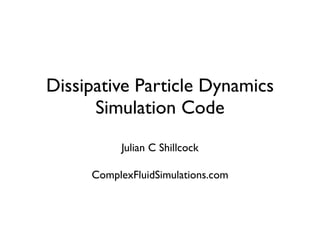
ComplexFluidSimulations
- 1. Dissipative Particle Dynamics Simulation Code Julian C Shillcock ComplexFluidSimulations.com
- 2. Outline • Code purpose • Major Features • Executable environment • Frameworks in the code • Publications
- 3. Code purpose • Simulate the material properties of complex fluids on the 1 nm - 200 nm length-scale for up to 100 microseconds • Visualize molecular rearrangements during biophysical processes such as vesicle fusion • Quantitatively model the structure and kinetics of drug delivery vehicles such as vesicles and polymersomes
- 4. Major Features • Box size and number of bead and molecule types limited only by hardware (RAM); approximately 0.5 kB required per bead • Largest system so far is a planar bilayer containing 28,000 amphiphiles and a vesicle containing 5800 amphiphiles in a box 100 x 100 x 42 nm3 • Wide range of initial state builders: random, restart, planar bilayer, vesicle, vesicle-bilayer fusion, two-vesicle fusion, wormlike micelle, ... • A simulation requires only a single ASCII input file (except for restarts) • Commands can be issued to a running simulation to modify its evolution; currently there are over 200 commands implemented
- 5. Executable environment • Written in ANSII standard C++ making extensive use of the STL • Single, stand-alone executable • Runs under Windows, Linux (Intel 7.0 compiler) and Macintosh • RAM footprint linear in system size: ~ 0.5 KB/particle • (42 nm)3 fusion event lasting 320 ns takes 40 cpu-hours* * Run time depends on system complexity, e.g. commands
- 6. Frameworks
- 7. Infrastructure frameworks • Experiment - wraps the complete code • Simulation - evolves the system’s dynamics • Monitor - extracts observables for analysis • Security - restricts access to licensed features • Messages - Logs command execution and significant events • Active Elements - dynamically-created molecules Red frameworks not fully implemented yet
- 8. State frameworks • Initial - contains complete information on the initial configuration of a simulation • Restart - contains complete information to continue a simulation from a saved state • Rebuild - allows extraction of geometric entities (e.g., a vesicle) from one run and insertion into another • Targets - allows user to select entities during a simulation and to analyse them or send commands to them
- 9. Control frameworks • Processes - allow user to control and monitor specified behaviour, e.g., vesicle fusion • Events - used by processes to watch for specified simulation states and take action when they occur • Commands - used to control aspects of the experiment’s behaviour before and during a run; commands may modify the simulation’s evolution or just change analysis options
- 10. Publications • Equilibrium structure and lateral stress distribution of amphiphilic bilayers from dissipative particle dynamics simulations Shillcock, J.C., and Lipowsky, R. J. Chem. Phys. 117:5048 (2002) • Tension-induced fusion of bilayer membranes and vesicles Shillcock, J. C. and Lipowsky, R. Nature Mat. 4:225 (2005) • Effect of chain length and asymmetry on material properties of bilayer membranes Illya, G., Lipowsky, R. and Shillcock, J. C. J. Chem. Phys. 122:244901 (2005) • Dissipative particle dynamics of polymersomes Ortiz,V. et al., J. Phys. Chem. B (Web release date August 30, 2005; doi 10.1021/ jp0512762 S1089-5647(05)01276-9